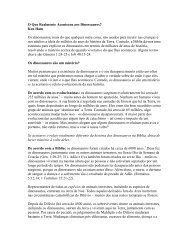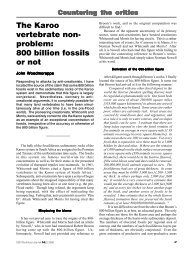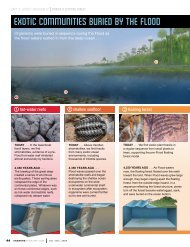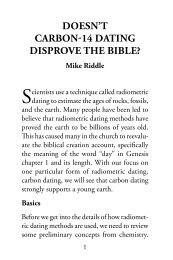Determining the Ark Kinds - Answers in Genesis
Determining the Ark Kinds - Answers in Genesis
Determining the Ark Kinds - Answers in Genesis
Create successful ePaper yourself
Turn your PDF publications into a flip-book with our unique Google optimized e-Paper software.
196<br />
The underly<strong>in</strong>g Hebrew word for k<strong>in</strong>d here is ןימ,<br />
mîn. It, along with <strong>the</strong> Hebrew word for create (ארב,<br />
bārā’), was used to co<strong>in</strong> <strong>the</strong> word baram<strong>in</strong>, a creationist<br />
term for created k<strong>in</strong>d. While <strong>the</strong> word baram<strong>in</strong> has<br />
strong taxonomic connotations to most creationists,<br />
Hebrew scholars have warned aga<strong>in</strong>st assum<strong>in</strong>g that<br />
ןימ is a technical term (Turner 2009; Williams 1997).<br />
Both Williams (1997) and Turner (2009) suggest that<br />
ןימ can be understood to refer to subdivisions with<strong>in</strong><br />
a larger group much like <strong>the</strong> mean<strong>in</strong>g of <strong>the</strong> English<br />
word k<strong>in</strong>d. So caution needs to be exercised <strong>in</strong> this<br />
area.<br />
Plants are described as be<strong>in</strong>g created accord<strong>in</strong>g to<br />
<strong>the</strong>ir k<strong>in</strong>ds with seed (ערז, zera’), imply<strong>in</strong>g <strong>the</strong>y were<br />
to reproduce (<strong>Genesis</strong> 1:11–12). Aquatic and fly<strong>in</strong>g<br />
creatures, after be<strong>in</strong>g created accord<strong>in</strong>g to <strong>the</strong>ir k<strong>in</strong>ds,<br />
were blessed and told to reproduce to fill <strong>the</strong> earth<br />
(<strong>Genesis</strong> 1:22). A similar bless<strong>in</strong>g was pronounced<br />
on humans (<strong>Genesis</strong> 1:28) along with a command<br />
for <strong>the</strong>m to rule <strong>the</strong> earth. S<strong>in</strong>ce life was created<br />
“accord<strong>in</strong>g to <strong>the</strong>ir k<strong>in</strong>ds” and told to reproduce, it is<br />
often assumed that life reproduces accord<strong>in</strong>g to its<br />
k<strong>in</strong>d. While Scripture does not emphatically state<br />
that life reproduces only after its own k<strong>in</strong>d, <strong>the</strong>re is a<br />
very strong <strong>in</strong>ference given both <strong>the</strong> biblical text and<br />
observations made <strong>in</strong> <strong>the</strong> world today.<br />
The account of <strong>the</strong> Flood seems to re<strong>in</strong>force this<br />
understand<strong>in</strong>g. God told Noah:<br />
And of every liv<strong>in</strong>g th<strong>in</strong>g of all flesh you shall br<strong>in</strong>g<br />
two of every sort <strong>in</strong>to <strong>the</strong> ark, to keep <strong>the</strong>m alive with<br />
you; <strong>the</strong>y shall be male and female. Of <strong>the</strong> birds after<br />
<strong>the</strong>ir k<strong>in</strong>d, of animals after <strong>the</strong>ir k<strong>in</strong>d, and of every<br />
creep<strong>in</strong>g th<strong>in</strong>g of <strong>the</strong> earth after its k<strong>in</strong>d, two of every<br />
k<strong>in</strong>d will come to you to keep <strong>the</strong>m alive. (<strong>Genesis</strong><br />
6:19–20).<br />
Notice verse 19 mentions two of all liv<strong>in</strong>g th<strong>in</strong>gs,<br />
a male and a female, are to come on <strong>the</strong> <strong>Ark</strong>. The<br />
obvious purpose is for reproduction (cf. <strong>Genesis</strong> 7:2,<br />
3, and 9). This is adjacent to a verse mention<strong>in</strong>g <strong>the</strong><br />
preservation of animals accord<strong>in</strong>g to <strong>the</strong>ir k<strong>in</strong>ds,<br />
aga<strong>in</strong> specify<strong>in</strong>g two of each. A very similar situation<br />
is found <strong>in</strong> <strong>the</strong> next chapter.<br />
<strong>the</strong>y [Noah and family] and every beast after its k<strong>in</strong>d,<br />
all cattle after <strong>the</strong>ir k<strong>in</strong>d, every creep<strong>in</strong>g th<strong>in</strong>g that<br />
creeps on <strong>the</strong> earth after its k<strong>in</strong>d, and every bird after<br />
its k<strong>in</strong>d, every bird of every sort. And <strong>the</strong>y went <strong>in</strong>to<br />
<strong>the</strong> ark to Noah, two by two, of all flesh <strong>in</strong> which is <strong>the</strong><br />
breath of life. So those that entered, male and female<br />
of all flesh, went <strong>in</strong> as God had commanded him; and<br />
<strong>the</strong> LORD shut him <strong>in</strong>. (<strong>Genesis</strong> 7:14–16)<br />
These pairs of animals were brought on <strong>the</strong> <strong>Ark</strong><br />
for <strong>the</strong> purpose of preserv<strong>in</strong>g <strong>the</strong>ir seed (<strong>Genesis</strong> 7:3;<br />
ערז, zera’). Word-for-word translations render ערז as<br />
offspr<strong>in</strong>g (for example New American Standard Bible,<br />
J. K. Lightner, T. Hennigan, G. Purdom, and B. Hodge<br />
English Standard Version, New English Translation),<br />
clarify<strong>in</strong>g th<strong>in</strong>gs s<strong>in</strong>ce <strong>the</strong> modern English word<br />
“seed” has a narrower semantic range than <strong>the</strong><br />
Hebrew word. The New International Version, which<br />
is more of a dynamic equivalence translation, renders<br />
<strong>the</strong> encompass<strong>in</strong>g phrase: “to keep <strong>the</strong>ir various<br />
k<strong>in</strong>ds alive throughout <strong>the</strong> earth.” Thus, where ןימ is<br />
used <strong>in</strong> <strong>the</strong> Creation or Flood accounts, it seems to be<br />
referr<strong>in</strong>g to dist<strong>in</strong>ct groups of animals and strongly<br />
imply<strong>in</strong>g that reproduction occurs with<strong>in</strong> <strong>the</strong>se<br />
groups (Table 1).<br />
Methods for Ascerta<strong>in</strong><strong>in</strong>g Baram<strong>in</strong>s<br />
(Created <strong>K<strong>in</strong>ds</strong>)<br />
Hybridization<br />
Based on <strong>the</strong> concept that liv<strong>in</strong>g th<strong>in</strong>gs reproduce<br />
accord<strong>in</strong>g to <strong>the</strong>ir k<strong>in</strong>ds, hybrids between different<br />
species of animals has long been considered conclusive<br />
evidence that both species belong to <strong>the</strong> same created<br />
k<strong>in</strong>d (baram<strong>in</strong>). For example, crosses between dogs<br />
and wolves, wolves and coyotes, and coyotes and<br />
jackals are <strong>in</strong>terpreted to mean that all <strong>the</strong>se species<br />
of animals belong to a s<strong>in</strong>gle baram<strong>in</strong>.<br />
Reproduction is a complex process and sometimes<br />
barriers arise that make it more difficult. This can<br />
be seen <strong>in</strong> attempts to form hybrids between different<br />
species. When cattle are crossed with bison, live<br />
hybrids are formed. However, <strong>the</strong> males are sterile.<br />
The females can generally reproduce and can be<br />
crossed with ei<strong>the</strong>r parent species. For this reason,<br />
cattle and bison are considered to belong to <strong>the</strong> same<br />
baram<strong>in</strong>, but are not <strong>the</strong> same species because <strong>the</strong>y<br />
cannot consistently produce fertile offspr<strong>in</strong>g. Crosses<br />
between horses and donkeys produce a mule, which is<br />
rarely fertile <strong>in</strong> ei<strong>the</strong>r sex.<br />
More serious barriers to reproduction can be apparent<br />
with<strong>in</strong> a baram<strong>in</strong>. Sheep and goats were identified as<br />
belong<strong>in</strong>g to <strong>the</strong> same baram<strong>in</strong> because several live<br />
hybrids have been produced between <strong>the</strong>m. However,<br />
a live hybrid is not <strong>the</strong> most common result when<br />
<strong>the</strong>se species mate with each o<strong>the</strong>r. In one study, when<br />
rams were mated with does (female goats) fertilization<br />
was fairly common, although not as high as mat<strong>in</strong>gs<br />
with<strong>in</strong> <strong>the</strong> respective species. The hybrid embryos died<br />
with<strong>in</strong> 5 to 10 weeks. When <strong>the</strong> cross was made <strong>the</strong><br />
o<strong>the</strong>r direction, bucks (male goats) mated with ewes,<br />
fertilization did not occur (Kelk et al. 1997).<br />
So how much development is necessary for<br />
hybridization to be considered successful? Is<br />
fertilization enough? The answer to <strong>the</strong> latter question<br />
is clearly no, as human sperm can fertilize hamster<br />
eggs <strong>in</strong> <strong>the</strong> laboratory. 3 Even <strong>the</strong> first few divisions<br />
are under maternal control. For this reason Scherer<br />
(1993) stated that embryogenesis must cont<strong>in</strong>ue until<br />
3 It should be noted that just because we report on <strong>the</strong> results of certa<strong>in</strong> laboratory f<strong>in</strong>d<strong>in</strong>gs does not necessarily imply we believe<br />
a specific procedure is ethical.







